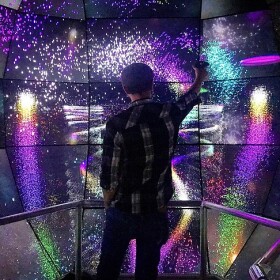Researchers at the Qualcomm Institute at UC San Diego are commemorating the second year of the Suncave.
Jürgen Schulze is the computer scientist at Qualcomm who developed the software for this project.
"Here we are in the Suncave. The Suncave is a virtual reality environment that can display a half a billion pixels. And with that it is the highest resolution virtual reality environment on the planet," Schulze said.
He’s pretty sure it is the highest resolution cave in the world because he said no one has contradicted him yet. And the cave can display a variety of projects.
On my visit to the cave, a bright digital art piece bounced countless colorful pixels, while transcendent music played overhead. The whole structure, with its 70 4K resolution screens, is powered by 35 computers.
Schulze said UCSD researchers or even companies that want to rent out the cave can use it to display data in three dimensional format. For instance, it can show an excavation site in Israel that was captured with drone technology. One can navigate through the site via a controller.
"The moment you hold it, that’s when you start the motion, and then you slightly move your hand in the direction you want to fly. And the more you move your hand that faster you fly," Schulze said.
Schulze also shows off a floating hemoglobin blood cell protein that researchers can view in depth. And a mockup for a new student center, that he says an architectural firm could use to show a client what it might be like to walk up a flight of stairs.
The point of this data visualization is that it allows the viewer to see more complex data than in a static 2D format. And it’s all produced with two computing lab’s worth of energy and processing power. Though, Schulze said, virtual reality caves like this aren’t new.
"To render something on the cave walls, that’s not that new, the algorithms are the same they just had to be adapted to this particular geometry," he said. "But we then developed new algorithms that allowed us to render more points and more high resolution data sets in this space because there’s so much more detail the displays can produce."
The Suncave was built about two years ago. It follows Qualcomm’s StarCave, which only supported around 60 million pixels., just 10% of what this cave can render.
Schulze said researchers can apply for a grant to produce a project in the SunCave, or if an organization has a project that would be enhanced with 70 high resolution TV screens, the cave can be rented.







